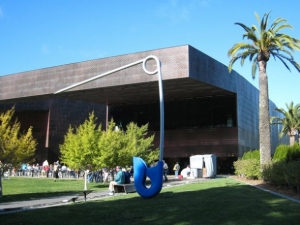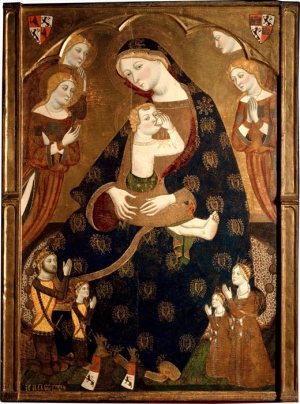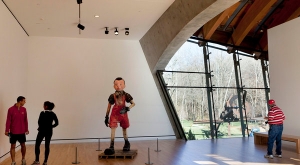|
Displaying items by tag: Art Museum
Hurrah. Another American museum has gotten it right, bracing against the tide of disastrous new buildings and additions that ruin and sometimes cripple so many of these institutions.
The cause for celebration is a makeover at the venerable Wadsworth Atheneum here, which opened its doors in 1844 and is this country’s oldest art museum in continuous operation. It joins a growing list of successful expansions and refurbishments that may mark the end of an era of architectural indulgence that began in 1978 with the opening of the National Gallery’s East Wing, the putative mother of useless event spaces that nourish neither art nor the people who love it.
A new museum in Washington will showcase a wide variety of art, history and culture through ancient textiles and a significant collection on the history of the nation's capital — while also signaling a major expansion in the arts for George Washington University.
The university opened the $33 million complex Saturday on its downtown campus where two museums will share one facility. The six-story complex is the new home for Washington's 90-year-old Textile Museum and its collection of 19,000 artifacts, along with a new museum featuring maps and documents tracing the capital city's history.
The Freer Gallery of Art – the Smithsonian’s first art museum – will close for 18 months for renovations beginning Jan. 4, 2016, officials announced Wednesday.
Repairs to the 180,000-square-foot building, a National Historic Landmark, will include updating the climate control systems and installing technological upgrades to its auditorium and storage and conservation areas. In addition, some of the galleries will be returned to the original aesthetic created by architect Charles Platt.
The Texas Department of Transportation has reached an agreement with the foundation Ballroom Marfa to preserve Elmgreen & Dragset’s iconic conceptual installation “Prada Marfa.” Ballroom Marfa, a non-profit organization that doubles as a contemporary cultural arts space, has been battling to preserve the sculpture for nearly a year. The government threatened to shut down the life-size replica of a Prada store, which stands on a deserted stretch of West Texas highway, because it could be considered an illegal roadside advertisement under state law.
To resolve the problem, Ballroom Marfa decided to lease the land underneath “Prada Marfa” and register the site as an art museum. Elmgreen & Dragset’s building will be the museum’s sole art exhibit.
The wealth, land and art collections of Richard Mellon Scaife, the late owner of the Tribune-Review, will be distributed among two foundations, a trust, an art museum and a conservancy, according to his will.
The will does not specify any individuals as benefactors, and lists only one sum, $15 million, which will go to the Brandywine Conservancy & Museum of Art for maintenance and management of a conservancy Scaife built on the grounds of his childhood home.
Scaife, an heir to the Scaife and Mellon fortunes, died on July 4, a day after his 82nd birthday.
Madrid's top art museum the Prado unveiled a major show Monday about the master painter El Greco, exploring his influence on modern greats such as Francis Bacon and Jackson Pollock.
"El Greco and Modern Painting" is part of a year-long series of big exhibitions to mark the 400th anniversary of the Greek-born master's death.
El Greco's works languished in obscurity until the late 19th century, but once collectors noticed them he became one of the most important figures in the history of art, influencing Picasso at the start of the Cubist movement.

After 15 months without a director, the Fine Arts Museums of San Francisco will appoint Colin B. Bailey, a deputy director at the Frick Collection in New York, the head of the consortium. Bailey, 57, is a renowned specialist in 18th and 19th century French art and has been at the Frick since 2000.
The Fine Arts Museums of San Francisco, which includes the modern-leaning M.H. de Young Memorial Museum and the neoclassical California Palace of the Legion of Honor, was left leader-less after the death of its previous director, John Buchanan, in 2011. The city of San Francisco and a private board of trustees oversee the museums, which collectively are the largest public arts institution in San Francisco and one of the largest art museums in the state of California.
The announcement, which was made by the museum board on Wednesday, March 27, 2013, comes after a considerable period of tumult among the museums; the past year has included tense labor negotiations, firings of senior staff members, and scathing criticism of the board’s president, Diane Wilsey. Wilsey, an art collector, philanthropist, and prominent San Francisco socialite, has been accused of using the museums’ resources for her own benefit and of nepotism.
The museums’ recent troubles have not deterred Bailey’s excitement to join the Fine Arts Museums. His abundance of museum experience includes stints at the National Gallery of Canada, the J. Paul Getty Museum in Los Angeles, the Philadelphia Museum of Art, and the Kimbell Art Museum in Fort Worth, Texas.

The Museo del Prado, the main Spanish national art museum located in Madrid, received the largest private donation in decades on Tuesday, January 29, 2013. Prado officials announced that the museum was the recipient of 12 medieval and Renaissance works by Spanish artists.
Barcelona-based businessman and engineer Jose Luis Varez donated the collection to the institution during a ceremony, which counted the Spanish Prime Minister Mariano Rajoy among its guests. Jose Pedro Perez Llorca, president of the Prado’s board of trustees, said, “These aren’t times of lavish state spending, so this donation is generous and tremendously timely.” Spain’s dire economic standing has led to severe spending cuts in an attempt to meet public deficit targets.
The recently acquired paintings and sculptures include the central panel of an altarpiece from a church in northeastern Spain titled The Virgin Tobed (1359). The Catalan Italo-Gothic painting is believed to be by 14th century artist Jaume Serra (died after 1405). The works will join the Prado’s exemplary collection, which includes paintings by Spanish masters such as El Greco (1541-1614), Diego Velázquez (1599-1660), and Francisco de Goya (1746-1828).
To thank Varez for his generous donation, the Prado will name a room in the museum in his honor.

By just about any measure, the Crystal Bridges Museum of American Art, which opened last month in this small town in northwest Arkansas, is off to a running start. The dream-come-true of Alice Walton, an heir to the Walmart fortune, it is characterized by people both inside and outside the museum as a work in progress, with plenty of room for improvement. But there it stands, a big, serious, confident, new institution with more than 50,000 square feet of gallery space and a collection worth hundreds of millions of dollars in a region almost devoid of art museums.
Much more than just a demonstration of what money can buy or an attempt to burnish a rich family’s name, Crystal Bridges is poised to make a genuine cultural contribution, and possibly to become a place of pilgrimage for art lovers from around the world.
It came into being in record time: it was only in May 2005 that Ms. Walton announced the selection of the Israeli-born Boston architect Moshe Safdie to design the museum and ruffled feathers along the Eastern Seaboard by buying a landmark of Hudson River School landscape painting, “Kindred Spirits,” by Asher B. Durand, from the New York Public Library for around $35 million. The purchase came early in an extended shopping spree that rattled nerves, aroused skepticism and stimulated the art market.
Today Crystal Bridges has a spacious and comfortable, if rather coarsely detailed, home set into a beautiful ravine carved by the Crystal Spring, from whence comes the name. (The land was once part of the Walton family property in Bentonville, where Ms. Walton’s father, Sam Walton, opened his first five-and-dime in 1951.) And it has a collection, spanning colonial times to the present, substantial enough to merit the use of the word “masterworks” in the title of its opening exhibition. This display of more than 400 paintings, sculptures and works on paper includes efforts by revered artists like Gilbert Stuart, Thomas Cole and Thomas Eakins and is especially outstanding in its representation of early-20th-century Modernism, with wonderful clusters of paintings by Marsden Hartley and Stuart Davis and two fabulous canvases by Arthur Dove.
The museum also has the beginning of a distinctive mission, which is to tie together American art and history and the immediate experience of nature in a compelling and accessible way, one that still keeps the art very much in the foreground.
This mission seems built into Mr. Safdie’s design, which consists of eight linked pavilions that border or span two large pools that are fed by the spring (and that unfortunately were empty and still being worked on when I visited this month). In a way that seems slightly confused, the arrangement evokes aspects of the Getty’s hilltop campus in Los Angeles, of Frank Lloyd Wright’s Fallingwater in western Pennsylvania and of a fancy theme park, minus the rides.
But there is an undeniable brilliance to this physical dispersal; you are never far from the outdoors, never cocooned by a maze of galleries. Moving through the building becomes something of a tour of its remarkable setting.
|
|
|
|
|